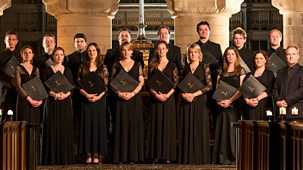
Episode 09 April 2023
Celebrated British choral group Tenebrae brings its trademark passion and precision to a dramatic programme of music, contrasting Bach’s iconic motets with sacred works by Sir James MacMillan. \n\nRenowned for their technical difficulty, Bach’s motets are pillars of the choral repertoire. However, there is some uncertainty as to the extent that motets would have been called for in normal church services, given there is evidence that the form was considered archaic. Scholars have suggested their use might have been pedagogical, a form of choral writing useful for training Bach's young singers. This could apply, in particular, to Singet dem Herrn ein neues Lied (Sing unto the Lord a new song), which ends the performance and may have been composed to provide choral exercises for Bach's students at the Thomasschule. The motet's biblical text would have been well suited to that purpose with the final four-part fugue titled Alles was Odem hat (All that have voice, praise the Lord!). Maybe that’s why Bach's motets are his only vocal works that remained in the canon without interruption between his death in 1750 and the 19th-century Bach revival led by Mendelssohn. The works famously require minute attention to detail as well as a full emotional range. Here, Tenebrae performs the three best known of the set, Komm Jesu komm, (Come, Jesus, come), Jesu meine Freude (Jesus, my joy), which is the longest and most musically complex of his motets, and the joyful Singet dem Herrn (Sing unto the Lord). \n\nLike Bach, MacMillan has written much of his music for the Church, and his settings of the Tenebrae Responsories paint a vivid picture of the events of Holy Week. The Responsories are a major work in MacMillan’s choral output, written for Cappella Nova in 2006 and first performed by them the following year at St Andrew’s in the Square, Glasgow. There are three movements, Tenebrae factae sunt, Tradiderunt me and Jesum Tradidit. Together they form a spiritually engaging and emotionally involving work which relates back in its searing intensity and some of its choral effects to Seven Last Words from the Cross (1993), one of MacMillan’s seminal earlier works. This work is also about the Crucifixion. The word Tenebrae, from which the choir takes its name, means darkness and refers to the Catholic practice of gradually extinguishing candles following readings of the Psalms in special Holy Week services.\n\nThe first movement is intensely chromatic, the second begins with three great choral outbursts of Tradiderunt me (They delivered me into the hands of the ungodly), returning at the end. They are then picked up at the start of the final movement with another three shouts of Jesum (Jesus was betrayed by the ungodly man…). The end is yet another example of MacMillan’s ability to give his audience something that will figuratively send them to their knees. A soprano solo emerges from a final impassioned choral phrase describing how Peter followed the procession to the Crucifixion from a distance to see the end, and he sings a dying soliloquy, a lament, walking off stage until he can no longer be heard. This remarkable work leaves a vivid impression in performance.\n\nIn 2021, MacMillan was asked to compose a work specifically for Tenebrae to perform alongside the Bach motets, and the result, which follows his Responsories, is a moving setting of words by Henry Vaughan, I Saw Eternity.
Source: BBC 4
Most recent episodes of Tenebrae: Bach to MacMillan
Tenebrae: Bach To Macmillan
Episode 09-04-2023
Celebrated British choral group Tenebrae brings its trademark passion and precision to a dramatic programme of music, contrasting Bach’s iconic motets with sacred works by ...
09-04-2023
BBC 4
Most popular episodes of Tenebrae: Bach to MacMillan
Tenebrae: Bach To Macmillan
Episode 09-04-2023
Celebrated British choral group Tenebrae brings its trademark passion and precision to a dramatic programme of music, contrasting Bach’s iconic motets with sacred works by ...
09-04-2023
BBC 4

